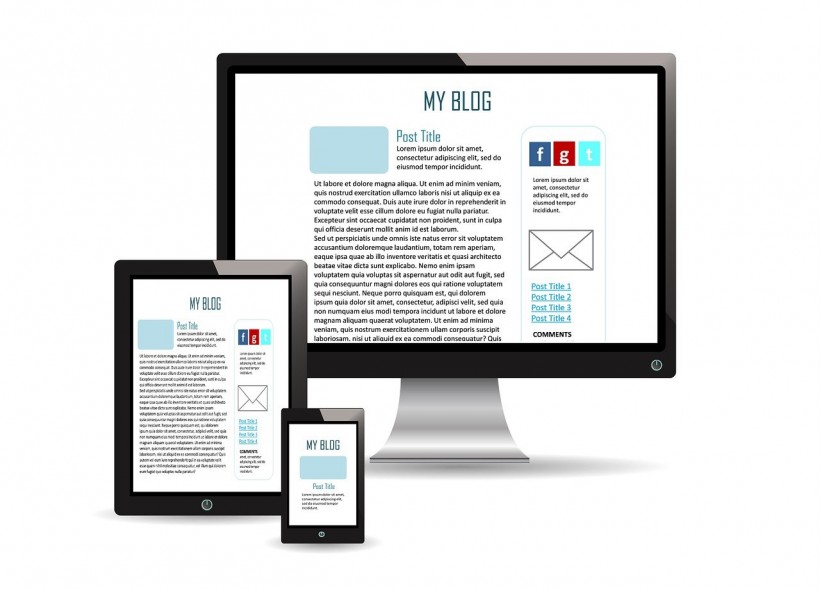
(Photo : Tumisu from Pixabay)
Did you know that 81% of U.S. customers trust advice and information from blogs? This means that bloggers are more trusted than celebrities, journalists, or politicians. But how can you make people fall in love with your blog from the start, aside from having exceptional content?
Just like the homepage of a website serves as the front door to a business, the design of your blog serves as the welcome mat to your business blog. If your blog doesn't visually attract visitors, how can you expect them to take the next step of actually reading your content and potentially subscribing to it?
Even if you publish high-quality content, a poorly designed blog can turn readers away. The way you showcase images, text, and links needs to be visually appealing and user-friendly for readers to stay engaged and navigate your blog effortlessly.
To help you create a stunning blog design that attracts and retains readers, we provide you with seven useful tips that will set you on the right track. So, let's dive in!
1. Use a Professionally-Designed Blog Theme
First impressions count! When readers visit your blog, the first thing they notice is its overall design and visual appeal. That's why it's crucial to have a professional-looking theme that will immediately grab their attention.
When choosing a theme for your blog, consider the following steps:
-
Define your blog's purpose and audience: Understand the goals and purpose of your blog. Identify your target audience and their preferences. This will help you determine the blog style, layout, and features that would appeal to them.
-
Research and explore different blog themes: Browse through reputable theme marketplaces or directories specific to your blogging platform (such as WordPress.org themes). Look for themes that catch your eye and align with your blog's niche or industry. Pay attention to the theme's design elements, layout options, and customization possibilities.
-
Consider design elements: Evaluate the visual appeal of the theme. Look for clean, modern designs that resonate with your blog's tone and content. Consider factors such as color schemes, typography, spacing, and overall aesthetics. Visualize how your content would appear within the theme's framework. To create a truly unique and tailored blog experience, you can order custom web design services that incorporate AR/VR elements and elevate your blog's visual appeal.
-
Choose a responsive and mobile-friendly theme: Ensure that the theme you choose is responsive and optimized for various screen sizes. Test the theme's demo on different devices to see how it adapts. A mobile-friendly design is crucial for providing a positive user experience for readers accessing your blog on smartphones and tablets.
By following these steps, you can make an informed decision and choose a theme that not only attracts readers but also complements your blog's content and goals.
2. Pick a Color Palette for Your Brand
A color palette consists of a thoughtfully selected range of colors that embody your brand's personality and are applied consistently throughout your website, social media channels, and marketing materials.
By carefully choosing a color palette, you can create a cohesive blog design that aligns with your brand identity. Additionally, leveraging color psychology enables you to evoke specific emotions in your audience, enhancing the impact of your blog design.
For instance, according to color psychology, blue is often associated with trust, loyalty, and reliability. Green is commonly linked to growth and freshness, while orange can evoke feelings of rejuvenation and positivity.
Take a moment to reflect on the colors that best represent your brand and consider how they might influence the emotions of your readers.
3. Incorporate a Captivating Header
Let's be honest-without a compelling headline, the likelihood of your blog posts being read significantly diminishes. Therefore, it is essential to invest time and effort into creating unique headers that capture attention and entice readers to delve into your content.
The design, colors, typography, and visuals featured in your blog header play a crucial role in making it captivating and visually appealing. Whether you aim for a professional, creative, elegant, or playful vibe, the header can instantly communicate that to your audience. It sets expectations and prepares readers for the type of content they can expect.
There are various strategies you can employ when designing your blog header, but one approach that stands out is making it unique and distinct. Your blog header should be crafted specifically for your blog, incorporating elements that represent your brand's identity (for example, logo, tagline, or brand colors). Consistency with your overall brand image helps build recognition and reinforces your blog's identity.
4. Use Clear Typography
While it may be tempting to use creative and unique typefaces to make your blog stand out, this can actually have negative consequences.
Fonts that imitate cursive handwriting pose challenges in terms of readability. The same principle applies to colored fonts and busy backgrounds.
When sharing valuable information, it's essential for your content to be easily understandable and accessible. This is why it's advisable to stick with commonly used fonts such as Arial, Times New Roman, and Trebuchet. These fonts are widely recognized, clear, and crisp, which ultimately makes your content easier to read.
If you decide to use a non-standard font, it is crucial to ensure its legibility on various devices, particularly mobile phones.
Additionally, you should ensure that the text provides sufficient contrast with the background and avoid using stark colors that can strain the eyes.
5. Break Up Text With Photos and Videos
Extensive blocks of text can quickly discourage readers, making it crucial to incorporate images and videos within your paragraphs. By blending text, visuals, and videos, you can significantly improve the flow of your article and increase reader engagement.
Including photos and videos in your content provides a visual break that captures readers' attention and keeps them invested in your message. These multimedia elements not only enhance the aesthetic appeal of your article but also serve as powerful tools for conveying information and evoking emotions.
When incorporating photos and videos, it's crucial to choose visuals that complement your text and convey your intended message effectively. Make sure the images are of high quality, properly sized, and appropriately captioned to provide additional context.
Lastly, remember to strike a balance between text and visuals. Avoid overwhelming your readers with an excessive number of images or videos that may distract from the main points. As a general guideline, including a visual element every 200 to 300 words is recommended.
6. Embrace Minimalism
Minimalism has become a popular trend in blog design. Embracing the "less is more" philosophy doesn't necessarily mean reducing the word count of your content.
To incorporate minimalism into your blog posts, consider the following tips:
-
Begin your blog post with concise sentences and paragraphs.
-
strategically utilize white space to create a sense of balance, improve readability, and draw attention to key elements
-
Incorporate easy-to-understand tables and bulleted lists whenever possible.
-
Utilize relevant animations, videos, infographics, images, and GIFs, but avoid excessive use.
-
Display ads in a manner that doesn't interrupt the user's experience or lead them away from your blog.
-
Limit the number of call-to-action buttons, and "contact us" forms to ensure a more comfortable reading experience.
7. Integrate Social Media Buttons
When it comes to integrating social media buttons into your blog design, their placement requires careful consideration.
Positioning them at the beginning of an article may be too early for readers to take action and share your content. Similarly, placing social buttons at the end of an article might be too late, as readers have already completed their reading task.
Instead, place them:
-
In-line with posts: By positioning social buttons within the content, specifically in the middle of the article, users are more likely to engage and share the content while they are still fully immersed in reading.
-
In floating bars: Utilize floating bars that move alongside the article as users scroll down the page. This way, social media buttons remain accessible and visible throughout the reading experience. Users who pay maximum attention to the subject matter, are more inclined to share the article.
8. Embracing Augmented Reality and Virtual Reality (AR/VR) in Blog Design
Innovative technologies like augmented reality (AR) and virtual reality (VR) are transforming the landscape of web design, offering exciting possibilities for creating immersive and interactive experiences.
Incorporating AR/VR elements into your blog design can captivate readers and elevate their engagement with your content. When considering AR/VR integration in your blog design, it's essential to explore the services and expertise offered by the list of top companies for AR/VR made by Design Rush, in order to make informed decisions.
Imagine allowing your readers to explore a virtual 3D environment related to your blog topic or enabling them to interact with virtual objects that enhance their understanding of the subject matter.
AR/VR can also be utilized to create interactive product showcases, virtual tours, or gamified experiences that make your blog truly unforgettable. By leveraging the power of AR/VR, you can add a new dimension to your blog design and provide readers with a unique and memorable browsing experience.
Conclusion
Creating a stunning blog design that attracts and retains readers requires careful attention to various aspects of your blog's visual presentation and user experience.
By choosing an appealing theme and color pallet, using legible fonts, incorporating captivating headers, and breaking the text of visuals and media, you can create a visually engaging and user-friendly blog.
By continually evaluating and refining your design choices based on user feedback and industry trends, you can create a blog that not only stands out visually but also provides an enjoyable and immersive reading experience for your audience.
* This is a contributed article and this content does not necessarily represent the views of hngn.com








